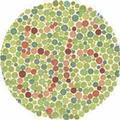|
Test For Color Blindness Information
Taking a test for color blindness is one of the only ways to tell if you have this condition, at least some of the time. In a lot of people, their color blindness is readily visible, and may even affect their day-to-day life. In other people, the vision changes aren't nearly as prominent, and there are dozens of different levels of color blindness known in the world at this current moment. Someone with a color vision deficiency could have anywhere from an extremely mild case to a severe case. The normal human eye can distinguish between roughly 100 different hues. Some people can see a little bit more. This means that anybody who can see even marginally fewer hues most likely has some sort of color vision deficiency, even if it's only 90 hues that they can see. People who have extreme Color Blindness can only see around 20 individual hues. Think about it: all of the colors that you can see right now consist of around 100 individual different colors. What if that number was cut down to a fifth of its original? Everything would blend together a lot more. You would still be able to tell all of the objects around you with no trouble, and there wouldn't be any issue with recognizing people or faces, but most of the things around you would be the same color. Also, remember that you wouldn't only see in black and white either. Color Blindness isn't being blind of color, as the name would suggest, and the real name for the condition is simply color vision deficiency, because you are deficient in a particular pigment in the cones of your Retina.
The Ishihara test for color blindness capitalizes on this fact to make it easier to determine whether or not someone is colorblind. This test uses circles with numbers inside them. The circles are one color, while the numbers are another. These are usually arranged in color combinations that coincide with the most common Types of Color Blindness , for example Red Green Color Blindness . To these people, there's no difference between red and green; they both look the same. So if the background of the circle is green and the number inside the circle is red, technically a person who is red green colorblind wouldn't be able to see the number. Of course, since they're not actually blind the person might still be able to recognize the outline of the number, so the Ishihara test There are different versions of the a href='https://www.protect-your-eyesight.com/color-blindness-test.html'> Color Blindness Test , but they all work on the same principle. If you think you might be color vision deficient, you can look for an online color blindness test, but it's still a good idea to get an opinion from your Eye Care Professional or
Eye Care Specialist.

Subscribe to EyeSight Vision Care! , our monthly newsletter with in depth information to help you keep up to date on how to Protect Your Eyesight with a free bonus. Fill out the form below. You'll then receive an email asking you to confirm that you subscribed. You'll always have the option to unsubscribe at the click of your mouse.
Test For Color Blindness to Color Blindness Test Charts
|
More Information

















